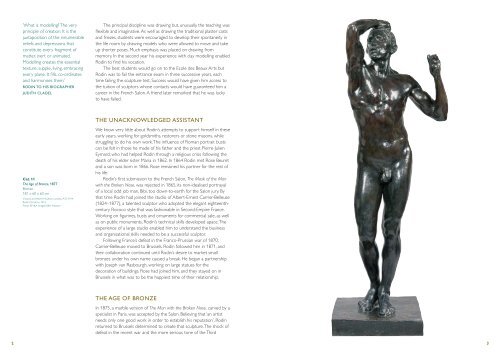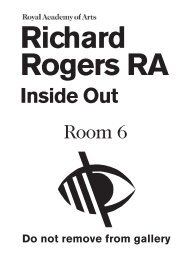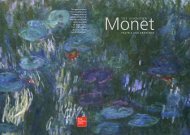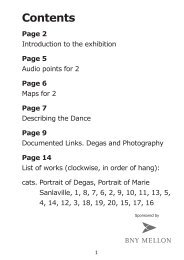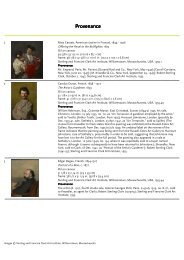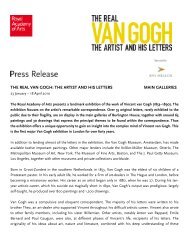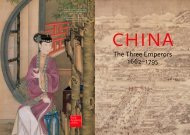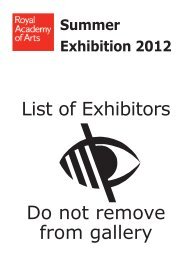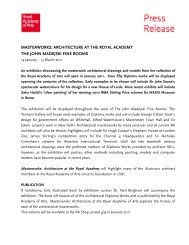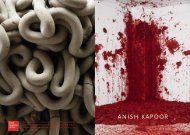rodin - Royal Academy of Arts
rodin - Royal Academy of Arts
rodin - Royal Academy of Arts
You also want an ePaper? Increase the reach of your titles
YUMPU automatically turns print PDFs into web optimized ePapers that Google loves.
2<br />
‘What is modelling? The very<br />
principle <strong>of</strong> creation. It is the<br />
juxtaposition <strong>of</strong> the innumerable<br />
reliefs and depressions that<br />
constitute every fragment <strong>of</strong><br />
matter, inert or animated.<br />
Modelling creates the essential<br />
texture, supple, living, embracing<br />
every plane. It fills, co-ordinates<br />
and harmonises them.’<br />
RODIN TO HIS BIOGRAPHER<br />
JUDITH CLADEL<br />
Cat. 11<br />
The Age <strong>of</strong> Bronze, 1877<br />
Bronze<br />
181 x 60 x 60 cm<br />
Victoria and Albert Museum, London, A33-1914.<br />
Rodin Donation, 1914<br />
Photo © V&A Images/V&A Museum<br />
The principal discipline was drawing but, unusually, the teaching was<br />
flexible and imaginative. As well as drawing the traditional plaster casts<br />
and friezes, students were encouraged to develop their spontaneity in<br />
the life room by drawing models who were allowed to move and take<br />
up shorter poses. Much emphasis was placed on drawing from<br />
memory. In the second year his experience with clay modelling enabled<br />
Rodin to find his vocation.<br />
The best students would go on to the Ecole des Beaux <strong>Arts</strong> but<br />
Rodin was to fail the entrance exam in three successive years, each<br />
time failing the sculpture test. Success would have given him access to<br />
the tuition <strong>of</strong> sculptors whose contacts would have guaranteed him a<br />
career in the French Salon. A friend later remarked that he was lucky<br />
to have failed.<br />
THE UNACKNOWLEDGED ASSISTANT<br />
We know very little about Rodin’s attempts to support himself in these<br />
early years, working for goldsmiths, restorers or stone masons, while<br />
struggling to do his own work.The influence <strong>of</strong> Roman portrait busts<br />
can be felt in those he made <strong>of</strong> his father and the priest Pierre-Julien<br />
Eymard, who had helped Rodin through a religious crisis following the<br />
death <strong>of</strong> his elder sister Maria in 1862. In 1864 Rodin met Rose Beuret<br />
and a son was born in 1866. Rose remained his partner for the rest <strong>of</strong><br />
his life.<br />
Rodin’s first submission to the French Salon, The Mask <strong>of</strong> the Man<br />
with the Broken Nose, was rejected in 1865, its non-idealised portrayal<br />
<strong>of</strong> a local odd job man, Bibi, too down-to-earth for the Salon jury. By<br />
that time Rodin had joined the studio <strong>of</strong> Albert-Ernest Carrier-Belleuse<br />
(1824–1877), a talented sculptor who adopted the elegant eighteenthcentury<br />
Rococo style that was fashionable in Second-Empire France.<br />
Working on figurines, busts and ornaments for commercial sale, as well<br />
as on public monuments, Rodin’s technical skills developed apace.The<br />
experience <strong>of</strong> a large studio enabled him to understand the business<br />
and organisational skills needed to be a successful sculptor.<br />
Following France’s defeat in the Franco-Prussian war <strong>of</strong> 1870,<br />
Carrier-Belleuse moved to Brussels. Rodin followed him in 1871, and<br />
their collaboration continued until Rodin’s desire to market small<br />
bronzes under his own name caused a break. He began a partnership<br />
with Joseph van Rasbourgh, working on large statues for the<br />
decoration <strong>of</strong> buildings. Rose had joined him, and they stayed on in<br />
Brussels in what was to be the happiest time <strong>of</strong> their relationship.<br />
THE AGE OF BRONZE<br />
In 1875, a marble version <strong>of</strong> The Man with the Broken Nose, carved by a<br />
specialist in Paris, was accepted by the Salon. Believing that ‘an artist<br />
needs only one good work in order to establish his reputation’, Rodin<br />
returned to Brussels determined to create that sculpture.The shock <strong>of</strong><br />
defeat in the recent war and the more serious tone <strong>of</strong> the Third<br />
3


